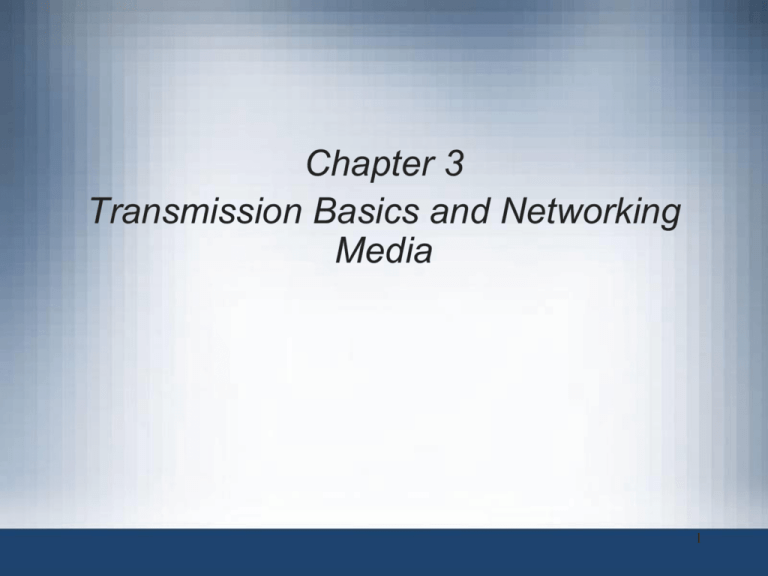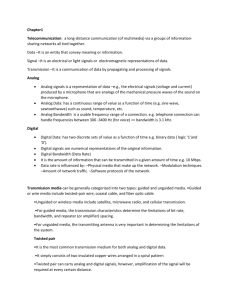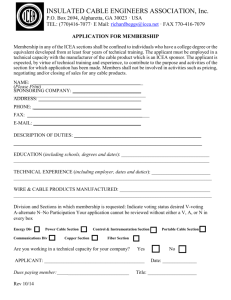Network+ Guide to Networks 6th Edition
advertisement

Chapter 3 Transmission Basics and Networking Media 1 Objectives • Explain basic data transmission concepts, including full duplexing, attenuation, latency, and noise • Describe the physical characteristics of coaxial cable, STP, UTP, and fiber-optic media • Compare the benefits and limitations of different networking media • Explain the principles behind and uses for serial cables • Identify wiring standards and the best practices for cabling buildings and work areas 2 Transmission Basics • Transmit – Issue signals along network medium • Transmission – Process of transmitting – Signal progress after transmitting • Transceiver – Transmits and receives signals 3 Analog and Digital Signaling • Important data transmission characteristic – Signaling type: analog or digital • Volt – Electrical current pressure • Electrical signal strength – Directly proportional to voltage – Signal voltage • Signals – Current, light pulses, electromagnetic waves 4 Analog and Digital Signaling (cont’d.) • Analog data signals – Voltage varies continuously • Fundamental properties of analog signals – Amplitude • Measure of strength at given point in time – Frequency • Number of times amplitude cycles over fixed time – Wavelength • Distance between one peak and the next – Phase • Progress of wave over time compared to a fixed point 5 Figure 3-1 An example of an analog signal Courtesy Course Technology/Cengage Learning 6 Figure 3-2 Waves with a 90 degree phase difference Courtesy Course Technology/Cengage Learning 7 Analog and Digital Signaling (cont’d.) • Analog signal benefit over digital – More variable • Convey greater subtleties with less energy • Drawback of analog signals – Varied and imprecise voltage • Susceptible to transmission flaws • Digital signals – Pulses of voltages • Positive voltage represents a 1 • Zero voltage represents a 0 8 Figure 3-3 An example of a digital signal Courtesy Course Technology/Cengage Learning Figure 3-4 Components of a byte Courtesy Course Technology/Cengage Learning 9 Analog and Digital Signaling (cont’d.) • Convert byte to decimal number – Determine value represented by each bit – Add values • Convert decimal number to a byte – Reverse the process • Convert between binary and decimal – By hand or calculator 10 Analog and Digital Signaling (cont’d.) • Digital signal benefit over analog signal – More reliable – Less severe noise interference • Digital signal drawback – Many pulses required to transmit same information • Overhead – Nondata information – Required for proper signal routing and interpretation – Example: network layer addressing information 11 Data Modulation • Data relies on digital transmission • Network connection may handle only analog signals • Modem – Accomplishes translation – Modulator/demodulator • Data modulation – Technology modifying analog signals – Make data suitable for carrying over communication path 12 Data Modulation (cont’d.) • Carrier wave – Combined with another analog signal – Produces unique signal • Transmitted from one node to another – Preset properties – Purpose: convey information • Information wave (data wave) – Added to carrier wave – Modifies one carrier wave property 13 Data Modulation (cont’d.) • Frequency modulation – Carrier frequency modified by application of data signal • Amplitude modulation – Carrier signal amplitude modified by application of data signal • Digital subscriber line (DSL) – Also makes use of modulation 14 Figure 3-5 A carrier wave modified through frequency modulation Courtesy Course Technology/Cengage Learning 15 Simplex, Half-Duplex, and Duplex • Simplex – Signals travel in one direction • Half-duplex transmission – Signals travel in both directions • One at a time – Shared communication channel • Full-duplex – Signals travel in both directions simultaneously – Used on data networks 16 Figure 3-6 Simplex, half-duplex, and full-duplex transmission Courtesy Course Technology/Cengage Learning 17 Simplex, Half-Duplex, and Duplex (cont’d.) • Channel – Distinct communication path between nodes – Separated physically or logically • Full duplex advantage – Increases speed of data travel • Some modems and NICs allow specifying half- or full-duplex communication – Modern NICs use full duplex by default 18 Multiplexing • Multiplexing – Multiple signals – Travel simultaneously over one medium • Subchannels – Logical multiple smaller channels • Multiplexer (mux) – Combines many channel signals • Demultiplexer (demux) – Separates combined signals – Regenerates them 19 Multiplexing (cont’d.) • Time division multiplexing (TDM) – Divides channel into multiple time intervals Figure 3-7 Time division multiplexing Courtesy Course Technology/Cengage Learning 20 Multiplexing (cont’d.) • Statistical multiplexing – Transmitter assigns slots to nodes • According to priority, need – More efficient than TDM Figure 3-8 Statistical multiplexing Courtesy Course Technology/Cengage Learning 21 Multiplexing (cont’d.) • Frequency division multiplexing (FDM) – Unique frequency band for each communications subchannel – Cellular telephone transmission – DSL Internet access Figure 3-9 Frequency division multiplexing Courtesy Course Technology/Cengage Learning 22 Multiplexing (cont’d.) • Wavelength division multiplexing (WDM) – One fiber-optic connection – Carries multiple light signals simultaneously Figure 3-10 Wavelength division multiplexing Courtesy Course Technology/Cengage Learning 23 Multiplexing (cont’d.) • Dense wavelength division multiplexing (DWDM) – Used on most modern fiber-optic networks – Extraordinary capacity 24 Relationships Between Nodes • Point-to-point transmission – One transmitter and one receiver • Point-to-multipoint transmission – One transmitter and multiple receivers • Broadcast transmission – One transmitter and multiple, undefined receivers – Used on wired and wireless networks – Simple and quick • Nonbroadcast – One transmitter and multiple, defined recipients 25 Figure 3-11 Point-to-point versus broadcast transmission Courtesy Course Technology/Cengage Learning 26 Throughput and Bandwidth • Throughput – Amount of data transmitted during given time period – Also called capacity or bandwidth – Expressed as bits transmitted per second • Bandwidth (strict definition) – Difference between highest and lowest frequencies medium can transmit – Range of frequencies – Measured in hertz (Hz) 27 Table 3-1 Throughput measures Courtesy Course Technology/Cengage Learning 28 Baseband and Broadband • Baseband transmission – Digital signals sent through direct current (DC) pulses applied to wire – Requires exclusive use of wire’s capacity – Transmit one signal (channel) at a time – Example: Ethernet • Broadband transmission – Signals modulated as radio frequency (RF) analog waves – Uses different frequency ranges – Does not encode information as digital pulses 29 Transmission Flaws • Noise – Any undesirable influence degrading or distorting signal • Types of noise – EMI (electromagnetic interference) • Example: radio frequency interference – Cross talk • Signal on one wire infringes on adjacent wire signal • Near end cross talk (NEXT) occurs near source 30 Figure 3-12 Cross talk between wires in a cable Courtesy Course Technology/Cengage Learning 31 Transmission Flaws (cont’d.) • Attenuation – Loss of signal’s strength as it travels away from source • Signal boosting technology – Analog signals pass through amplifier • Noise also amplified – Regeneration • Digital signals retransmitted in original form • Repeater: device regenerating digital signals – Amplifiers and repeaters • OSI model Physical layer 32 Figure 3-13 An analog signal distorted by noise and then amplified Courtesy Course Technology/Cengage Learning Figure 3-14 A digital signal distorted by noise and then repeated Courtesy Course Technology/Cengage Learning 33 Transmission Flaws (cont’d.) • Latency – Delay between signal transmission and receipt – May cause network transmission errors • Latency causes – Cable length – Intervening connectivity device • Round trip time (RTT) – Time for packet to go from sender to receiver, then back from receiver to sender 34 Common Media Characteristics • Selecting transmission media – Match networking needs with media characteristics • Physical media characteristics – – – – – Throughput Cost Noise immunity Size and scalability Connectors and media converters 35 Throughput • Most significant factor in choosing transmission method • Causes of throughput limitations – – – – Laws of physics Signaling and multiplexing techniques Noise Devices connected to transmission medium • Fiber-optic cables allow faster throughput – Compared to copper or wireless connections 36 Cost • Precise costs difficult to pinpoint • Media cost dependencies – Existing hardware, network size, labor costs • Variables influencing final cost – – – – – – Installation cost New infrastructure cost versus reuse Maintenance and support costs Cost of lower transmission rate affecting productivity Cost of downtime Cost of obsolescence 37 Noise Immunity • Noise distorts data signals – Distortion rate dependent upon transmission media • Fiber-optic: least susceptible to noise • Limit noise impact on network – Cable installation • Far away from powerful electromagnetic forces – Select media protecting signal from noise – Antinoise algorithms 38 Size and Scalability • Three specifications – Maximum nodes per segment – Maximum segment length – Maximum network length • Maximum nodes per segment dependency – Attenuation and latency • Maximum segment length dependency – Attenuation and latency plus segment type 39 Size and Scalability (cont’d.) • Segment types – Populated: contains end nodes – Unpopulated: no end nodes • Also called link segment • Segment length limitation – After certain distance, signal loses strength • Cannot be accurately interpreted 40 Connectors and Media Converters • Connectors – Hardware connecting wire to network device – Specific to particular media type – Affect costs • Installing and maintaining network • Ease of adding new segments or nodes • Technical expertise required to maintain network • Media converter – Hardware enabling networks or segments running on different media to interconnect and exchange signals 41 Figure 3-15 Copper wire-to-fiber media converter Courtesy of Omnitron Systems Technology 42 Coaxial Cable • Central metal core (often copper) surrounded by: – Insulator – Braided metal shielding (braiding or shield) – Outer cover (sheath or jacket) Figure 3-16 Coaxial cable Courtesy Course Technology/Cengage Learning 43 Coaxial Cable (cont’d.) • High noise resistance • Advantage over twisted pair cabling – Carry signals farther before amplifier required • Disadvantage over twisted pair cabling – More expensive • Hundreds of specifications – RG specification number – Differences: shielding and conducting cores • Transmission characteristics 44 Coaxial Cable (cont’d.) • Conducting core – American Wire Gauge (AWG) size – Larger AWG size, smaller wire diameter • Data networks usage – – – – RG-6 RG-8 RG-58 RG-59 45 Figure 3-17 F-Type connector Figure 3-18 BNC connector Courtesy of MCM Electronics, Inc. © Igor Smichkov/Shutterstock.com 46 Twisted Pair Cable • Color-coded insulated copper wire pairs – 0.4 to 0.8 mm diameter – Encased in a plastic sheath Figure 3-19 Twisted pair cable Courtesy Course Technology/Cengage Learning 47 Twisted Pair Cable (cont’d.) • More wire pair twists per foot – More resistance to cross talk – Higher-quality – More expensive • Twist ratio – Twists per meter or foot • High twist ratio – Greater attenuation 48 Twisted Pair Cable (cont’d.) • Hundreds of different designs – Twist ratio, number of wire pairs, copper grade, shielding type, shielding materials – 1 to 4200 wire pairs possible • Wiring standard specification – TIA/EIA 568 • Most common twisted pair types – Category (cat) 3, 5, 5e, 6, 6a, 7 – CAT 5 or higher used in modern LANs 49 Twisted Pair Cable (cont’d.) • Advantages – – – – – Relatively inexpensive Flexible Easy installation Spans significant distance before requiring repeater Accommodates several different topologies • Two categories – Shielded twisted pair (STP) – Unshielded twisted pair (UTP) 50 STP (Shielded Twisted Pair) • Individually insulated • Surrounded by metallic substance shielding (foil) – Barrier to external electromagnetic forces – Contains electrical energy of signals inside – May be grounded Figure 3-20 STP cable Courtesy Course Technology/Cengage Learning 51 UTP (Unshielded Twisted Pair) • One or more insulated wire pairs – Encased in plastic sheath – No additional shielding • Less expensive, less noise resistance Figure 3-21 UTP cable Courtesy Course Technology/Cengage Learning 52 Comparing STP and UTP • Throughput – STP and UTP can transmit the same rates • Cost – STP and UTP vary • Connector – STP and UTP use Registered Jack 45 – Telephone connections use Registered Jack 11 53 Comparing STP and UTP (cont’d.) • Noise immunity – STP more noise resistant • Size and scalability – Maximum segment length for both: 100 meters 54 Terminating Twisted Pair Cable • Patch cable – Relatively short cable – Connectors at both ends • Proper cable termination techniques – Basic requirement for two nodes to communicate • Poor terminations: – Lead to loss or noise • TIA/EIA standards – TIA/EIA 568A – TIA/EIA 568B 55 Figure 3-24 TIA/EIA 568A standard terminations Figure 3-25 TIA/EIA 568B standard terminations Courtesy Course Technology/Cengage Learning Courtesy Course Technology/Cengage Learning 56 Terminating Twisted Pair Cable (cont’d.) • Straight-through cable – Terminate RJ-45 plugs at both ends identically • Crossover cable – Transmit and receive wires on one end reversed Figure 3-26 RJ-45 terminations on a crossover cable Courtesy Course Technology/Cengage Learning 57 Terminating Twisted Pair Cable (cont’d.) • Termination tools – Wire cutter – Wire stripper – Crimping tool • After making cables: – Verify data transmit and receive 58 Fiber-Optic Cable • Fiber-optic cable (fiber) – One or more glass or plastic fibers at its center (core) • Data transmission – Pulsing light sent from laser or light-emitting diode (LED) through central fibers • Cladding – – – – Layer of glass or plastic surrounding fibers Different density from glass or plastic in strands Reflects light back to core Allows fiber to bend 59 Fiber-Optic Cable (cont’d.) • Plastic buffer outside cladding – Protects cladding and core – Opaque to absorb escaping light – Surrounded by Kevlar (polymeric fiber) strands • Plastic sheath covers Kevlar strands Figure 3-30 A fiber-optic cable Courtesy of Optical Cable Corporation 60 Fiber-Optic Cable (cont’d.) • Different varieties – Based on intended use and manufacturer Figure 3-31 Zipcord fiber-optic patch cable Courtesy Course Technology/Cengage Learning 61 Fiber-Optic Cable (cont’d.) • Benefits over copper cabling – – – – – Extremely high throughput Very high noise resistance Excellent security Able to carry signals for longer distances Industry standard for high-speed networking • Drawbacks – More expensive than twisted pair cable – Requires special equipment to splice 62 SMF (Single-Mode Fiber) • Consists of narrow core (8-10 microns in diameter) – Laser-generated light travels over one path • Little reflection – Light does not disperse as signal travels • Can carry signals many miles: – Before repeating required • Rarely used for shorter connections – Due to cost 63 MMF (Multimode Fiber) • Contains core with larger diameter than single-mode fiber – Common sizes: 50 or 62.5 microns • Laser or LED generated light pulses travel at different angles • Greater attenuation than single-mode fiber • Common uses – Cables connecting router to a switch – Cables connecting server on network backbone 64 Fiber-Optic Converters • Required to connect multimode fiber networks to single-mode fiber networks – Also fiber- and copper-based parts of a network Figure 3-38 Single-mode to multimode converter Courtesy Omnitron Systems Technology 65 Serial Cables • Data transmission style – Pulses issued sequentially, not simultaneously • Serial transmission method – RS-232 • Uses DB-9, DB-25, and RJ-45 connectors 66 Structured Cabling • Cable plant – Hardware that makes up the enterprise cabling system • Cabling standard – TIA/EIA’s joint 568 Commercial Building Wiring Standard • Also known as structured cabling • Based on hierarchical design 67 Figure 3-42 TIA/EIA structured cabling in an enterprise Courtesy Course Technology/Cengage Learning 68 Structured Cabling (cont’d.) • Components – – – – – – – – Entrance facilities MDF (main distribution frame) Cross-connect facilities IDF (intermediate distribution frame) Backbone wiring Telecommunications closet Horizontal wiring Work area 69 Structured Cabling (cont’d.) Table 3-2 TIA/EIA specifications for backbone cabling Courtesy Course Technology/Cengage Learning 70 Best Practices for Cable Installation and Management • Choosing correct cabling – Follow manufacturers’ installation guidelines – Follow TIA/EIA standards • Network problems – Often traced to poor cable installation techniques • Installation tips to prevent Physical layer failures – See Pages 121-122 in the text 71 Summary • Information transmission methods – Analog – Digital • Multiplexing allows multiple signals to travel simultaneously over one medium • Full and half-duplex specifies whether signals can travel in both directions or one direction at a time • Noise distorts both analog and digital signals • Attenuation – Loss of signal as it travels 72 Summary (cont’d.) • Coaxial cable composed of core, insulator, shielding, sheath • Types of twisted pair cable – Shielded and unshielded • Fiber-optic cable transmits data through light passing through the central fibers 73 Summary (cont’d.) • Fiber-optic cable categories – Single and multimode fiber • Serial communication often used for short connections between devices • Structured cabling standard provides wiring guidelines 74






